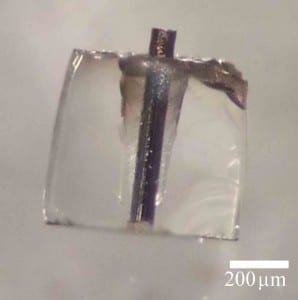
Researchers at Tohoku University in Japan have developed a new low-cost flat panel light source that could pioneer a new generation of brighter, cheaper and greener lighting devices to rival LEDs.
The device uses arrays of highly conductive carbon nanotubes to deliver evenly-distributed illumination with high efficiency and a power consumption as low as 0.1 Watts – about 100 times lower than that of light-emitting diodes.
LED lights are renowned for their high efficiencies, but the fact that only a fraction of the photons they produce actually ends up illuminating the surrounding environment suggests that there is still much room for improvement. One alternative approach explored by Prof. Norihiro Shimoi and colleagues was to build a structure based on carbon nanotubes, one-atom thick layers of carbon folded into a cylindrical shape.
This state-of-the-art device has a diode-like structure like LEDs but, curiously enough, the way in which it produces light is actually closer to the cathode ray tubes used in the TVs and computer monitors of the past century. Under the influence of a strong electric field, each carbon nanotube acts as a tiny cathode ray tube that releases a high-speed beam of electrons from its tip. These electrons then hit a phospor screen kept under vacuum and, in the process, release a small amount of energy that causes the phospor to glow.
Building the device was a fairly simple, low-cost process. The researchers started by mixing highly crystalline single-walled carbon nanotubes with an organic solvent and a surfactant compound. They then painted the mixture on the cathode and scratched the surface with sandpaper, which allows the electrons to more easily separate from the tip of the nanotubes.
The Latest on: Low-power light source
[google_news title=”” keyword=”Low-power light source” num_posts=”10″ blurb_length=”0″ show_thumb=”left”]
via Google News
The Latest on: Low-power light source
- What can we learn from Truckee’s power planning exercise?on April 28, 2024 at 5:30 am
TDPUD’s energy analysis recommends they evolve their portfolio with more wind (mostly from Idaho), solar plus storage (likely from Utah), and geothermal (likely from Nevada). Most California-based ...
- Eskom forecasts ‘light’ load shedding in winter after 30-day break from rolling blackoutson April 26, 2024 at 7:28 am
The power utility anticipates about 50 days of load shedding during the winter season, and a diesel cost of R8.8-billion to run its emergency gas turbines.
- What is BlueImage and can it help Vivo beat the Galaxy S24 Ultra in low light photography?on April 26, 2024 at 7:15 am
It also mentions where BlueImage technology can help: scenarios like clear backlighting and low-light night vision. The post also hints that imaging tech can be used for health monitoring (like early ...
- Rivers are the West’s largest source of clean energy. What happens when drought strikes?on April 26, 2024 at 1:15 am
In Washington, a dozen dams dot the Columbia River — that mighty waterway carved through the state by a sequence of prehistoric superfloods. Between those dams and the hundreds of others that plug the ...
- Destiny 2 Finally Undoes "Gunsetting" With The Final Shape's New Power Systemon April 25, 2024 at 2:20 pm
Guns from before the Beyond Light expansion that have Power limits will again be useful thanks to a new Fireteam Power system, but if you deleted your favorites, you're not out of luck.
- Long-term coal power plants must control 90% of their carbon pollution, new EPA rules sayon April 25, 2024 at 1:59 pm
The Biden administration says the new rules will reduce pollution from fossil fuel power plants, fighting climate change and improving public health.
- Prepare for low batteries of all kinds with this battery jump starter and power bank, only $69.99on April 25, 2024 at 7:25 am
TL;DR: Prepare for an emergency with a TYPE S 12V Battery Jump Starter. This compact gadget can give your car a jump, power your phone, or light a small room with built-in LEDs, and it’s available for ...
- KC may scrap plan for ‘low barrier’ shelter. Why such little progress on homeless goals?on April 25, 2024 at 3:44 am
The plan for Kansas City’s first low barrier shelter had been accepted by the city council in January, before progress stalled.
- Flat optics revolutionize quantum light sources for enhanced communication and sensingon April 24, 2024 at 5:00 pm
The convergence of flat optics and quantum light sources represents a major step forward in the quest for compact, efficient, and versatile quantum technologies. By harnessing the power of ...
- Power blackout: Nigerians express frustration, want speedy resolution of crisison April 24, 2024 at 6:16 am
Small business operators and residents in parts of the country have continued to decry the almost total power outage in their area, which ...
via Bing News









